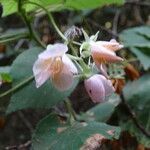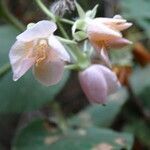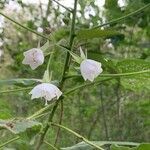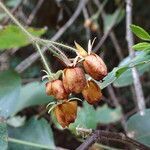Shrub, 1-4 m high with several to many stems, sometimes a slender tree. Branches stout, longitudinally ridged with fairly prominent leaf scars and many lenticels, more or less pubescent; ultimate branchlets comparatively slender, patently pubescent with a mixture of long, pointed, multicellular, thin-walled hairs and obtuse, glandular, multicellular hairs, hairs mostly over 1 mm long, single or two to several from the same base. Stipules variable, broadly ovate-acuminate from a broad subcordate base, narrowly oblong-acuminate, or narrowly lanceolate-acuminate, 1-1.7 cm long, 3-8 mm broad, densely to sparsely pubescent, glabrescent, from rather thick-textured and dark brown to fairly thin-textured and light brown. Leaves broadly ovate, 6-20 cm long, 5-19 cm broad, deeply cordate at the base, usually 3-5-lobed, sparsely to very densely pubescent with stellate and tufted hairs, lower surface usually more densely so than the upper, 5-7-palmately nerved, margins irregularly and unequally crenate to crenate-dentate; petiole 2-15 cm long, mostly thicker than the peduncles, ±1.5-2 mm long, usually sparsely to densely patently pilose at least in part, with multicellular, non-glandular, pointed hairs mixed to a greater or lesser degree with glandular hairs. Inflorescence cymose, axillary, 2-to several-flowered; peduncle longer or shorter than the subtending petiole and usually slightly more slender, 2-14 cm long, similarly pubescent, branched in the upper half; pedicels up to 3 cm long. Bracts 3, free to the base, early caducous, variable in size, shape and pubescence, narrowly or broadly oblong to ovate-subcordate, shortly acuminate to an acute or shortly caudate apex, 9-15 mm long, 3-8 mm broad, pubescent on both surfaces, shortly tomentose or less densely covered with stellate and long tufted hairs, inserted close to the calyx base or up to 1.5 mm distant. Calyx lobed almost to the base, the united portion (about 1.5 mm long) consolidated with the ovary base which is rounded or with a short stipe; lobes about 14 mm long, acuminate from a 3-4 mm wide base, dorsally pubescent. Petals white or pale pink, sometimes with a rose-pink centre, persistent, turning light brown with age, up to 20 mm long, 18 mm broad at the apex. Stamens united at the base for 2-4 mm, filaments of various lengths, up to 4.5 mm long; anthers 3-4 mm long; staminodes 10-13 cm long, 2 mm broad in upper half. Ovary about 6 x 6 mm, stellate-tomentose to hirsute with tufted hairs, normally 5-celled; style 8-14 mm long, glabrous or partly to wholly stellate-tomentose, 3-5-branched; ovules 3-4 in a cell. Capsule about 10 mm long, 8 mm broad, stellate-tomentose to hirsute with tufted hairs (hairs about 1 mm or more long), pubescent on the sutures within.
More
Leaf-lamina up to 18 × 18 cm., very broadly ovate-cordate, entire or crenate, unlobed or more usually 3–5-lobed with blunt or acuminate lobes, villous to sparsely pubescent on both surfaces, sometimes rather discolorous, 5–9-nerved at the base; petiole up to c. 12 cm. long; stipules 1–1·5 cm. long, lanceolate-acuminate to ovate-acuminate, pubescent or glabrescent.
Bush or shrub 2–4 m. tall, branching low down; stems with a brown bark, densely villous when young with 1–3-fid stellate hairs or hispid with mainly simple hairs, longer hairs mixed with shorter glandular hairs; indumentum of petioles, peduncles and pedicels similar but denser than that of the stems.
Flowers in many-flowered (rarely few-flowered) axillary corymbose cymes or more rarely in subumbellate cymes; peduncle ± equalling the petiole; pedicels up to 3 cm. long; bracts up to 1·2 cm. long, lanceolate-acuminate to broadly ovate, densely pubescent or villous.
Shrub or slender tree, up to 4 m high. Leavgs broadly ovate, 60-200 x 50-190 mm, deeply cordate at base, sparsely to very densely pubescent with stellate and tufted hairs. Petals up to 20 mm long. Flowers white or pale pink, turning light brown with age.
An erect shrub. It grows 2-4 m tall. The leaves are bright green and large and hairy. They are alternate and have lobes. The flowers are pink and in clusters. The fruit is a small round furry capsule.
Ovary ovoid, villous; loculi pubescent within; normally 4 ovules per loculus; style 0·5–1·2 cm. long, pubescent, at least in the lower half; stigmas 5, recurved.
Seeds 2·3 × 1·7 mm., dark brown, ellipsoid, up to 4 per loculus; testa minutely tessellated, with the surface-cells elongated.
Petals 1·5–2·7 × 1·5–2·4 cm., white with rose-pink guide-lines or rose-pink, asymmetrically obovate.
Calyx-lobes 1–2 × 0·3–0·5 cm., narrowly lanceolate-acuminate, densely pubescent to villous outside.
Stamens connate below for c. 2 mm.; staminodes up to c. 1·4 cm. long, linear, glabrous.
Capsule c. 1 cm. in diam., ovoid, villous.






